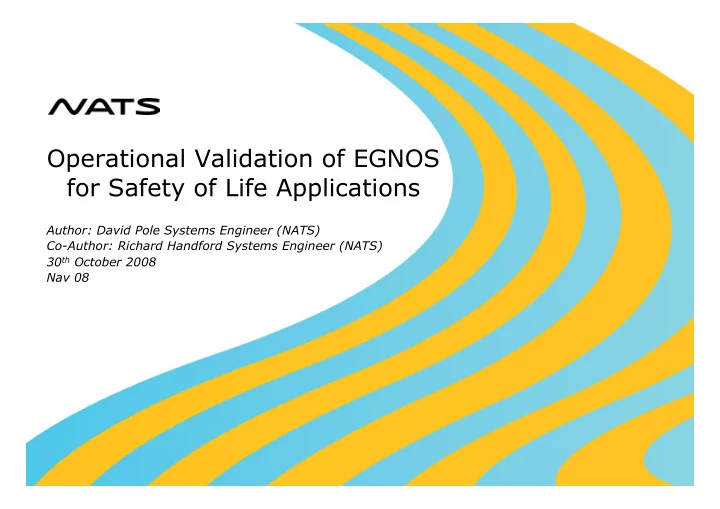

Operational Validation of EGNOS for Safety of Life Applications Author: David Pole Systems Engineer (NATS) Co-Author: Richard Handford Systems Engineer (NATS) 30 th October 2008 Nav 08
Presentation Overview • Validation Motivations • Validation Method • Performance Monitoring – Existing – Limitations • Validation Schedule • Monitoring EGNOS in NATS – Site Details – Processing Signal Content • Results from Tools • Conclusions n
Validation Motivations • Prove that EGNOS is usable for Safety of Life (SoL) Applications • Provide information to the EGNOS technical file, which will consist of the following: – Design Safety Case – Independent Assessment Report – Operations Safety Case • Objective of Independent Assessment Report is to demonstrate system fulfils safety requirement – Availability – Continuity – Integrity n
Validation Method • GSA Provide – Evaluation methodology recommendations – Data presentation recommendations – Harmonization report format. • Assess using data sourced from the following location – RIMS sites (ASQF input) – 6 independent locations (PACF input) – Eurocontrol’s EGNOS Data Collection Network (EDCN members) n
Performance Monitoring Networks EGNOS Performance Monitoring Actors • Image – Run by ESA as an independent network – Uses Network of Septentrio Polar Rx2 receivers – Members (AENA, ESA, ESSP, Inguassu, INMARSAT, NMA, PAS, ISMB, Skyguide, Universitat De Valencia) • EGNOS Data Collection Network (EDCN) – Run by Eurocontrol • Setup to develop and test processing tools • Devise ways of monitoring the system requirements – Uses various receivers – Providing data for the EGNOS Technical File – Members (Budapest, Delft & Sofia University, NATS, Eurocontrol, ESSP, Skyguide, DSNA, gAGE/UPC, Nav Portugal, ENAV, IntegNav, ENAC, AENA, Pildo) n
Validation Schedule • Validation will be carried out on V2.2 of EGNOS – In final deployment – Due to be fully deployed – Data for Independent assessment report collected on V2.2 • Data collection for validation will take place over a 6 month period • System is expected to be certified December 2009. n
Performance Monitoring Limitations Limitations • EGNOS provides location dependant corrections • Error sources can be introduced by the local environment • Receiver Issue – Common receiver problems – Most receivers used not certified • Hardware/tool problems n
NATS Performance Monitoring Facilities Southampton Setup • Certified Garmin Receiver • Ashtech Receiver Sumburgh Setup (Shetland Isles Lat 59.8 degress, Long -1.2) • 3 Novotel OEM receivers • Logging and Comms PC’s • Why Sumburgh – Poor user location – Edge of service area – RIMS distribution n
Assessing and Reducing Poor Effects of Logged Signals Local Processes • Removing aspects of the signal • Monitoring specific parameters of the signal Reducing Effects of Validation Environment • Reduce the effect of the multipath environment of the site • Use multiple receivers • Assess GPS code minus carrier-phase signal Quantifying the Ionospheric Correction • Value as seen at the performance monitoring site • The Ionospheric correction can be assed using data gained from the following sources: – EGNOS Ionospheric Correction – Ionospheric error calculated using L1 and L2 locally n
Estimating Components in the Signal • The residual from the code minis carrier signal is as follows: – ρ code – ρ phase = 2I + MEAScode + MEASphase + υ code - υ phase + Mcode – Mphase - ∆ • Component parts of the signal • There is a close relationship between the performance of two receivers closely spaced antenna. n
Separating Aspects of the Signal n
Method for Discriminating Multipath from Noise n
Reducing the Multipath Effects n
Visualising Effects of Multipath tool • Reduced mean variation • Most effect at low elevations n
Checking the Error in the Ionosphere n
Ionospheric Validation Tool Asessing the Error in the EGNOS Iono Correction • Determine a truth signal • Use delay derived from L1 and L2 GPS • Determine the error in the EGNOS Ionospheric correction • Ensures in Bounding • Does not acount for temperature variation Results from Tool • For times checked Ionospheric correction was well within bound • Not setup as an automated tool – Technical difficults to implement as automated check n
Conclusions Validating EGNOS • Data collection period for Validation is fast approaching • Performance Monitoring is important in gauging the capability of the system to provide safe information. Assessment of Local Environment • This reduction in the effects of Multipath will allow the SIS to be scrutinised fairly. • Does not propose a solution to completely eradicate the effects of Multipath, Assessment of the Ionospheric Correction • Ionospheric Correction from the data broadcast by EGNOS was well within the sigma values • Not an automated tool yet n
Thank you • For further information please contact the following: – David Pole (Systems Engineer) david.pole@nats.co.uk +44 (0)1489 444654 – Richard Handford (Systems Engineer) richard.handford@nats.co.uk +44 (0)1489 445365 n
Presentation Summary • Performance evidence will be used in the EGNOS technical File, therefore the evidence needs to provide a fair representation of the signal. • Monitoring EGNOS at the edge of service coverage will provide confidence in the systems overall performance. • Improving Limitations of performance monitoring site – Details of a method used to reduce Multipath based on assessing the difference between the Code Minus Carrier of two receivers is presented. – Additionally a method developed to assess the Ionosphere is showed. n
Notes • No integrity event has been seen since start of 2007 • Continuity around 10^-4 in core ECAC • SIS broadcast since start of 2008 • 6 RIMS to be deployed in 2.3-2.4 • ESA think system is ready for certification • GPS constellation may change over 6 months n
Recommend
More recommend